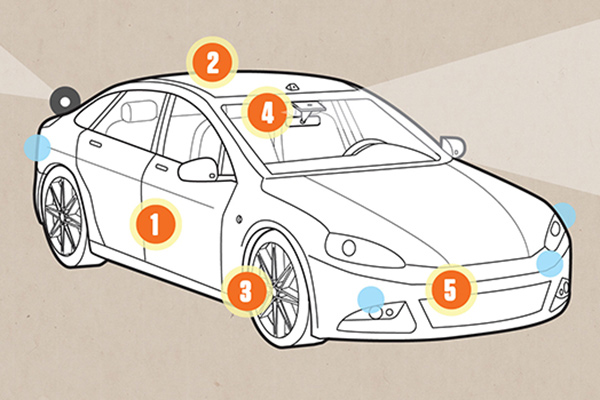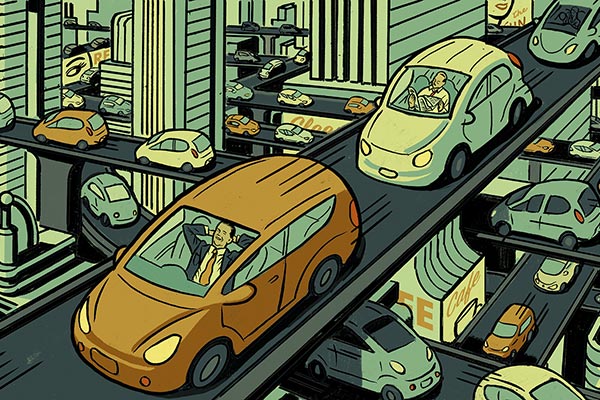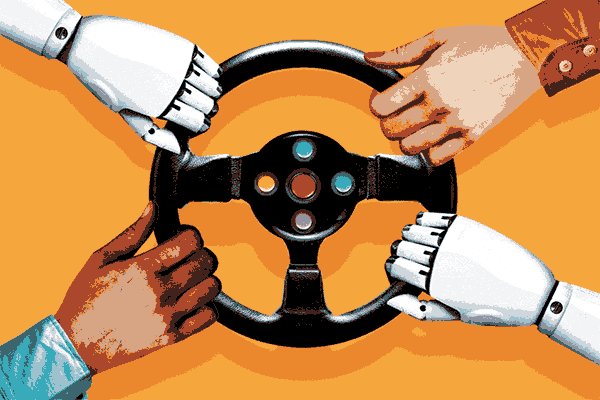Autonomous cars are already a reality—at least, they are in Phoenix, Ariz., where an autonomous vehicle company has partnered with a rideshare service. Its cars are already picking up and depositing riders—all without a human driver at the wheel.
While this has been a limited-scale project—in a city with normally good weather—being chauffeured around without a chauffeur is closer to becoming a common occurrence. The National Highway Traffic Safety Administration says that fully automated cars and trucks are on their way, 29 states have enacted legislation for allowing autonomous vehicles on their roads, and the U.S. Department of Transportation (DOT) recently announced plans to ease federal regulations surrounding autonomous vehicles.
The DOT’s rationale? Safety. As much as 94 percent of all serious automobile crashes are attributed to human error. Unlike human drivers, autonomous vehicles are not prone to distraction, fatigue or impaired driving.
So why aren’t we all buzzing around town in driverless vehicles? Why is it taking so long?
The Obstacles For Self-Driving Cars
There several issues that still need to be ironed out, say experts.
Weather
Just like a human driver, weather affects a driverless vehicle, says Melba Kurman, co-author of Driverless. If we can’t see in the fog, a camera can’t see in the fog, either—even an advanced camera that performs 360-degree scans up to 20 times per second and has deep-learning software to “teach” it to recognize objects.
However, that’s just one of the tools that autonomous vehicles use to “see.” There’s also LiDAR (light detection and ranging)—a sensing system that uses a spinning laser beam and calculates how long it takes for light to hit and then reflect back from an object. Cars also use radar, which measures radio waves to detect an object’s bearing, range and velocity.
Possible solution: Whether it’s LiDAR or better cameras that are used as the primary visual sensor, says Kurman, they are all feeding data into neural deep-learning networks and making autonomous driving systems smarter and better. “When companies are ready to invest in training driverless vehicles to handle snowy or foggy road conditions,” she says, “the cars’ performance will exceed that of a human driver.”
Liability & Insurance
This will be tricky, Kurman says, because if no one’s driving, who’s at fault if there’s an accident?
Possible solution: Policies and regulations will have to change to support the new technology—but they will, says Kurman. “Government and insurance companies will figure it out—after all, they’ve adapted to new technologies in the past.”
Non-standardized Road Markings
Signs and lights can vary by state—or even by municipality. Some traffic signals are horizontal, for example, while others are vertical. Plus, signs that mark the miles or exits along the highway aren’t the same from state to state, and if they’re damaged or old, they could be tough to read. If the car hasn’t learned all of the variables, there could be safety ramifications.
Possible solution: With artificial intelligence (AI) technology, computer-run vehicles are increasingly capable of learning at a rate far faster than humans. Eventually, cars will become smart enough that these variations won’t matter, says Paul Godsmark, chief technology officer of CAVCOE (formerly the Canadian Automated Vehicles Centre of Excellence), an Ontario-based nonprofit.
Recognition Of Objects
Road signs are one thing. But distinguishing between, say, a cat and a cardboard box—or a child and a small tree—can be tricky, and Godsmark says that companies are still working out kinks in image identification and classification.
Possible solution: With continued training, AI is getting better and better at recognizing objects—and is already better than humans in some circumstances, Godsmark says. AI is developing at an exponential rate, and any image-class problem that exists today might not be a problem in the near future.
Potential For Hacking
The cars’ computerized systems and the network of vehicles means that a security breach could have serious consequences. “When I go through things that would keep me up at night, this is at the top of the list,” Godsmark says.
Possible solution: “It gives me comfort,” Godsmark says, “that the tech companies leading autonomous-vehicle technology are world leaders in cyber security.”
Adoption Hesitancy
The handful of accidents involving autonomous vehicles have received lots of media attention; this could make people hesitant or unwilling to embrace autonomous vehicles.
Possible solution: If, say, 75 percent of people are unwilling to ride in a driverless vehicle, that’s good news, says Godsmark, because it means that 25 percent already are. “It’s a new technology and people are bound to be skeptical,” he says. “But once people try it, they’ll be won over.”
The Benefits Of Self-Driving Cars
Once the obstacles are overcome, these will be some of the benefits.
- Greater safety, less congestion. Driverless cars mean potentially fewer accidents, which can cause traffic backups.
- Environmentally beneficial. Autonomous vehicles will likely be smaller and electric-charged, rather than outfitted with fossil-fuel engines.
- Enhanced productivity. While you’re being driven to your destination, you can catch up on email and work calls—or do neither and take a nap.
- Greater independence. Older people and those with mobility issues will be able to remain self-sufficient by being able to easily travel to places like the grocery store, the movies or a restaurant.
Self-Driving Cars: How They Work
 You climb into your car, punch your destination into the GPS…and then curl up under a blanket for a nice nap while your vehicle drives itself there.
You climb into your car, punch your destination into the GPS…and then curl up under a blanket for a nice nap while your vehicle drives itself there.
Sound like a dream? Not quite.
With several manufacturers now developing technology for self-driving cars, many advancements are expected in the next few years. In fact, some experts have predicted that in our lifetime, we could be living in a world in which most cars on the roads will be driverless.
The basic components of self-driving cars already exist—they just need to be refined. Here’s a look at how most autonomous vehicles are wired.
1. Onboard Computer
Uses a neural network to process LIDAR and radar inputs.
2. Global Positioning System
GPS signals are combined with measurements from onboard meters for advanced location accuracy.
3. LIDAR Sensors
LIDAR (light detection and ranging) uses pulses of light to map nearby cars and objects
4. Hi-Def Cameras
Provide wide-range visibility to detect and identify traffic lights and road signs.
5. Forward-Facing Radar
Can detect other cars through inclement weather.
Wherever automotive technology goes, we’ll be there with solutions and savings. Speaking of which, now’s a great time to get a quote on auto insurance from GEICO and see if you could save!
Read more: 5 Hi-Tech Safety Features To Look For In A New Car
By Ellise Pierce and Mark Yarm










CS Ross says,
I wonder how similar peoples augments against self-driving cars are to what peoples arguments were against automobiles in the early 1900s. Automobiles were a high-tech, radical idea back then that many people resisted. Much had to change for cars to really take off including laws, infrastructure, and most importantly, peoples attitudes.
Stan says,
For those who mistakenly use their cars for adrenaline purposes on public roads and hence are against autonomous vehicles, there will be new business opportunities : All you can ride parks. Just like any other entertainment park, you pay a fee so that you can hop into conventional car and drive it on your own in a designated area. Something like Bungee Jumping or Sky Diving.
People are afraid of new things,that is normal but the advantages of autonomous vehicles will by far outweigh the shortcomings. My concern would be that just like virus can attack PC, one can envision hecking the programming of autonomous vehicle and letting it drive at full speed into a wall, effectively committing remote murder.
Gregg says,
Personally, I enjoy the activity of driving (except in traffic!), and like the feel of a machine responding to my control, be it vigorous or subtle. I think I would miss that physical involvement in the driving experience if I was just a passive observer!
Cameron says,
I’m ready. Can’t stay awake night driving anymore. Bring it!
Syaulan says,
It will benefit those who can’t drive a car, like elderly, disabled person.
Phillip Peach says,
I hope self driving cars take hold so I can get ride of high priced insurance
Greg Hawkins says,
I think the driverless cars or auto pilot modes on the highways would be great. I can then drive the 1500 miles to Texas and not have to stop and sleep. I also like the idea of the cars would be available for non drivers (think elderly) who could then get to shopping , hair and doctor appointments.
Daniel says,
I barely wait for the intelligent self driving cars to be mass produced. Quantity will drop their initial prices to decent affordable levels. The technology is here, but the big barriers are the social ones: the legislation, the human inertia and the bureaucracy.
To those people against:
– wait until you become old with poor vision or disabled and you’ll change your mind.
– nobody will force you to buy a self driving car. And if the choice disappears, I am sure you can switch on manual driving on any intelligent car (like on the planes manual or autopilot). Of course the manual mode should be recorded on the black box for liability in case of an accident.
George says,
Invasive Ads and Coupons continue to pop up on my too smart phone as I enter parking lots of stores like Pet Co. As well as many of the stores we frequent do the same . This whole electronic enchilada is way to hot for me. Cannot help wondering what else is up these corporation’s sleeve. Google and Apple advertising capsules. Suggestive mind altering theft of your privacy as you relax watching the entertainment pop out screen.
Sure hope the self driving motorcycle is not on the horizon. It is on it’s way to removing passion, romance and foreplay from our motoring experience. It is changing the working people down a notch again as the fat corporate cats line the pockets .
Zubair Ahmed Tariq says,
Even in Now a days, many driver minds are controlled and traffic police give them ticket even such people drive within speed. Such a shame of such Traffic police officer. Can we get Traffic police officers who are like this car i.e Working with sensors.
Many of such mind controlled people suffer a special disease called Schizophrenia, I will say it Artificial Schizophrenia. Procter and Gamble Pakistan , a famous American company is good for creating such artificial schizophrenia patients.
If sensor of such cars as mentioned baove got hacked like a human being brain, it can fell in a lake. Be careful.
Edison says,
Who is going to be responsible not if but when the car gets into an accident .
Laura says,
It sounds nice but I don’t think I would feel comfortable not having control of the car.
1. humans program the car and humans make mistakes.
2. A lot of parts in the car are already electrical and they when they break all of a sudden, it’s scary when the car is in control.
3. I’m nervous when I’m in the car with another driver.
Guess I’m old school.
Josh says,
1. This should be a point in favor of self driving cars. Humans make mistakes every time they drive: going over the speed limit, rolling stops at stop signs, texting, talking on the phone, eating, putting on makeup, fiddling with the radio… even just listening to music takes away some of our attention to the roads. The average driver has probably gone 20 years without taking a drivers test, who knows what they’ve forgotten in that time.
2. Many cars already have many electrical parts. Mechanical failure is not unique to autonomous cars. If a part failed in a person’s car, they would not be ready for it, and they probably wouldn’t know how to react. A self-driving car could be programmed to act immediately when something goes wrong and take the proper steps to ensure everyones’ safety.
3. You should be. You should be nervous when you’re the one driving too. Look up how many accidents happen every single day. Most of these could be avoided if cars were designed specifically to drive themselves around and prevent accidents.
Stan says,
Thanks! I sincerely endorse your words. People are prone to distraction and get emotional while driving. Machines don’t. Autonomous cars can communicate to each other via Wifi. Traffic lights are for humans, machines need Wifi beacon. Guess which one is cheaper to implement.
Barry M Graham says,
Amazing, this is the future, although it may be obsolete when autonomous drones are able to carry passengers, which may not be so far behind.
Jackson Velez says,
It’s a good idea for the elderly and for the handicap. I hope the price tag is reasonable.
Diane Conlon says,
I love the idea, but am not sure if I will be able to afford it. I hate driving on highways because I don’t trust the other drivers at high speeds -plus it is boring.